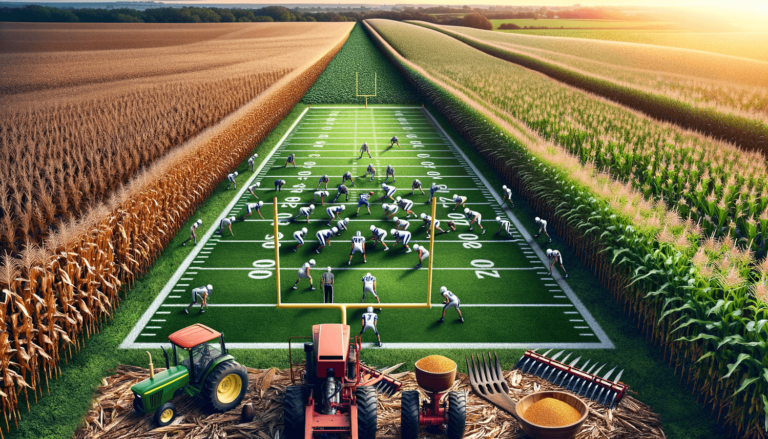
Agriculture in football refers to the essential role of natural grass and soil management in providing optimal playing surfaces. Proper turf care, including mowing, fertilizing, watering, and aeration, maintain pitch quality, player safety, and performance. Additionally, sustainable practices in agriculture help conserve resources and reduce the environmental impact of stadium operations.
Turf Management in Football
Agriculture plays a vital role in football through turf management. Natural grass pitches require proper care and maintenance to ensure optimal playing conditions for players and aesthetic appeal for spectators.
Grass Selection
Choosing the right type of grass is crucial for football pitch surfaces. Key factors to consider include climate, durability, and wear-resistance. Cool-season grasses, like Kentucky bluegrass or perennial ryegrass, are suitable for temperate regions, while warm-season grasses, like Bermuda grass or Zoysia grass, are better for warmer climates.
Soil Management
Soil composition and drainage affect the quality of the pitch. Proper soil management techniques, such as aeration, topdressing, and overseeding, improve soil structure, facilitate rooting, and promote turf recovery.
Fertilization in Football Fields
Balanced and timely nutrient applications promote a healthy and durable playing surface. Nitrogen, phosphorus, and potassium are the primary nutrients, while secondary nutrients, such as calcium, magnesium, and sulfur, are also crucial for grass growth and health.
Water Management
Efficient irrigation systems ensure that football fields receive adequate moisture without waterlogging or causing compaction. Monitoring soil moisture levels, adjusting irrigation schedules, and employing rain sensors help efficiently manage watering practices.
Pest and Disease Management
Maintaining a healthy and resilient turf reduces the likelihood of pest and disease infestations. Integrated pest management (IPM) strategies, combining biological, cultural, and chemical controls, aim to minimize infestations while reducing the environmental impact of chemicals.
Sustainable Practices in Football Agriculture
Implementing sustainable agriculture practices in football offers environmental, economic, and social benefits. Effective strategies include reducing pesticide use, conserving water resources, and recycling organic waste materials, such as grass clippings and leaves, to improve soil health and conserve resources.
Hybrid Grass Systems in Football
Hybrid grass systems combine natural grass with synthetic fibers to create durable and weather-resistant playing surfaces. This technology not only offers enhanced stability and resilience but also reduces the requirement for water and other resources compared to traditional natural grass pitches. Examples of hybrid systems include SISGrass and Mixto.
Maintaining Football Pitch Safety
Agricultural practices in football directly influence player safety. A well-maintained pitch with proper grass density and composition can help reduce the risk of injuries such as sprains, strains, and impact injuries. It also provides consistent ball roll and predictable play conditions, allowing players to perform at their best with reduced risk.
Importance of Turf Quality for Football Performance
Research has shown that there is a direct correlation between the quality of the playing surface and the players’ performance level. Good turf management techniques, including proper mowing, watering, and aerating, ensure an even playing surface that allows players to showcase their skills effectively during matches.
Alternative Playing Surfaces in Football
While natural grass remains the preferred playing surface in professional football, alternative options, such as artificial turf and hybrid grass systems, have gained popularity for their durability, versatility, and lower maintenance requirements. Implementing these alternative options can reduce the strain on natural resources while still maintaining high-quality playing conditions.
Agriculture in Football Academies
Football academies, where young talent is nurtured and developed, can also benefit from agricultural best practices. A well-maintained and safe training ground is essential for the holistic development of players and the promotion of healthy habits for young footballers. Sustainable practices in football academies contribute to conserving resources and supporting a future that values the environment.
FAQ: Agriculture and Football Pitches
We understand that reading about agricultural practices in football can raise additional questions. The following FAQ section will address some of the most common inquiries related to this topic.
How often should a football pitch be mowed?
A football pitch should be mowed regularly, typically two to three times a week during the growing season, depending on the region and grass type. Regular mowing, cutting at the correct height, helps maintain a consistent and healthy playing surface.
What is the ideal grass height for a football pitch?
Most professional football pitches maintain a grass height between 25mm and 30mm (about 1 to 1.2 inches). This height offers optimal balance between playability and durability, providing a suitable surface for players and minimizing turf wear and tear.
How do groundsmen deal with heavy rain on football pitches?
Groundsmen safeguard football pitches against heavy rain by employing various techniques, such as aerating and verti-draining to improve drainage, ensuring proper slope and base construction, and using temporary covers or tarps to protect the pitch during extreme weather conditions.
Can synthetic turf be more environmentally friendly than natural grass?
While synthetic turf installation requires fewer natural resources, such as water and fertilizers, to maintain, the production process and eventual disposal of the synthetic materials can have a significant environmental impact. When assessing environmental friendliness, one must weigh the resource conservation benefits against the production and disposal impacts of synthetic turf.
What steps can be taken to conserve water on football pitches?
Water conservation on football pitches can be achieved through a combination of strategies, such as using drought-tolerant grass species, optimizing irrigation systems, monitoring soil moisture levels, implementing rainwater harvesting, and incorporating water-saving technologies like rain sensors and evapotranspiration controllers.
Featured Posts
- No pillar pages found.





